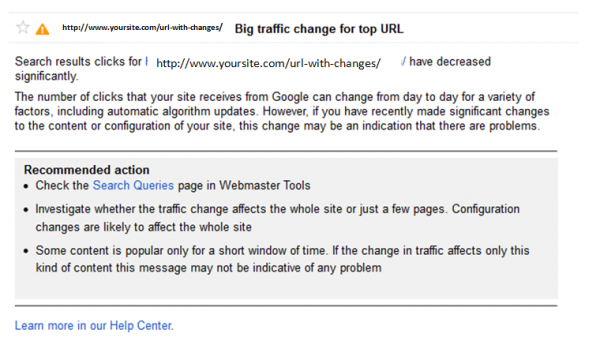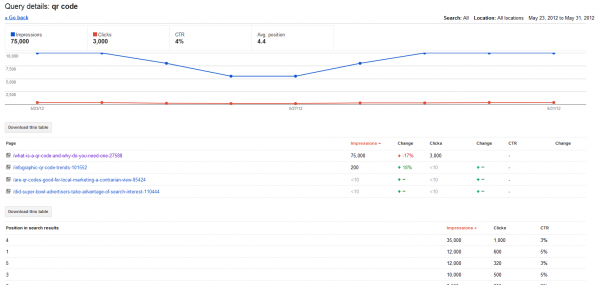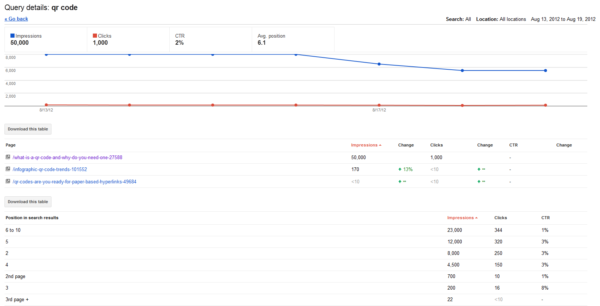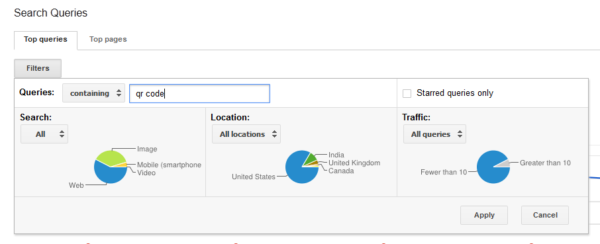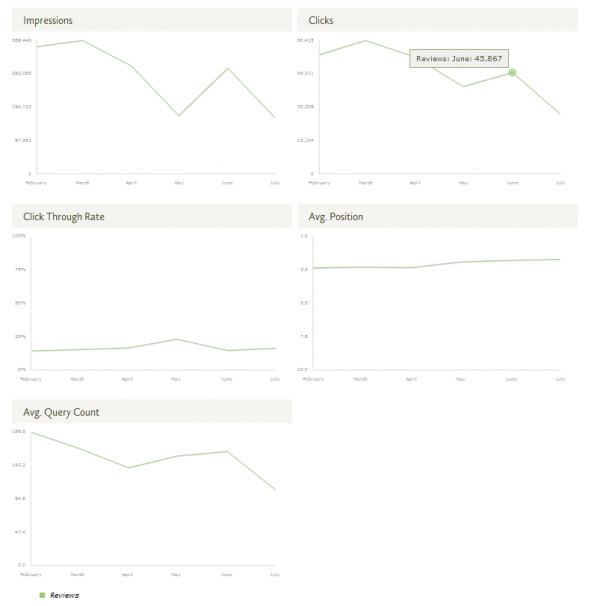Google Webmaster Tools Adds Clarity to Traffic Alerts: What To Do If You Receive One
For some time (since at least March), Google webmaster tools has been sending messages to site owners about substantial traffic changes (increases or decreases) to pages of a site. Some site owners found these messages perplexing as they weren’t sure exactly what was actionable about the messages. Were the messages just informational, intended to help […]
For some time (since at least March), Google webmaster tools has been sending messages to site owners about substantial traffic changes (increases or decreases) to pages of a site. Some site owners found these messages perplexing as they weren’t sure exactly what was actionable about the messages. Were the messages just informational, intended to help those who didn’t look at their analytics every day? Did they imply something specific about what Google knew about how the site? For instance, some people thought perhaps this was a warning message about a new penalty on the site or a penalty being removed from a site.
In reality though, these messages were just intended as a heads up to let site owners know when a page that previously brought substantial traffic to the site might be having issues of some kind (in the case of a traffic drop) or when a page may newly have become a traffic driver. Google’s latest blog post highlights that these messages have been revised to make that clearer. This is part of Google’s larger attempt to provide alerts of important issues related to sites.
If you receive a message about a traffic drop, your plan of action should be the same as any traffic drop investigation.
1. Is the page still indexed? If not, technical issues may at play.
Check:
- If the page has a meta robots tag in the source code preventing indexing (<meta name=”robots” content=”noindex”>).
- If the page is blocked from crawling via robots.txt (use Google’s robots.txt checker to test this).
- If the URL is listed in the Google Webmaster Tools crawl errors report (the easiest way to search for a specific URL is to download the CSV and search across all errors at once).
2. Is the page indexed, but with lower ranking?
The best way to check this is to go into Google Webmaster Tools and then navigate to Search Queries and then Top Pages. Once you find the page in the list, you can look at a couple of different things:
- Choose a date range from before the date of the drop and look at the average ranking for the page, then choose a date range post-drop and compare the average rankings and search volume.
- Click the expansion arrow to see the queries that brought traffic to that page and click the query that brought the most traffic to see detailed information for the selected date range. If the traffic dropped for that query, go to the Search Queries tab and compare the ranking for that query for a date range both before and after the drop to see if the rankings changed.
- First, we can look at the current average position of the URL (averaged across all queries that bring traffic to the page.
- Next, we can see if that ranking has changed over time by comparing two date ranges.
In this case, we can see that the ranking dropped from an average of 5.6 to 6.7. This likely is what caused the click through rate to decline from 5% to 3%. We can also see that overall search volume declined. Since in both ranking positions, the result was on the first page of results, then 100% searches would have registered as an impression. Does this mean that overall interest declined over this period or does the page rank for fewer queries? We can look at the query details to find out. - For each date range, click the expansion arrow beside the URL to see the queries the page got traffic for.
- When working with a large number of queries, I find it can be helpful to copy and paste the list into Excel. By alphabetizing each list and then comparing them side by side, you can see what queries dropped out, what new queries are bringing traffic now, and how traffic has changed for each query. You can then determine if you’ve lost visibility for a high volume query entirely, or if simply a lot of little long tail queries are adding up to big traffic changes.
- For high volume queries that have lost substantial traffic, you can check the query details report for that query. In this case, we’ll check the highest volume query, [qr code]. When you click the link in the UI, you see the details for that query (URLs that ranked, positions, and so on) for the selected date range. (You have to go back to the previous page to change the date range.)
In this case, we can see that the ranking for just [qr code] went from an average of 4.4 to 6.1, but that’s the average across all pages that ranked in any position for the query. - To get more details on just this URL/query pairing, we need to go back to the Search Queries report. You can filter by the query to make it easier to find (and can filter on country/platform specifics if you’d like as well.
- In this case, the average ranking for the URL and average ranking for the query are similar, but this may not always be the case. In some cases, a URL ranks for a number of varied queries — some at high positions and others at low positions, which makes the average ranking look fairly low. When looking at a specific query, you’ll see the high (or low) ranking position that goes into the URL average.
3. Are Rankings the Same? If so, have impressions or click through rate declined?
If rankings have held steady, then seasonality may be at play. As you can see above, at least part of the issue is due to fewer searches related to QR codes. If impressions haven’t declined, then check for changes in click through rate. At my company, Nine By Blue, we’ve built software that charts categorized query data: impressions, clicks, rankings, clicks through rate, and number of queries in a category over time to make it easy to tell which factor may be causing traffic drops. In the example below, you can see for all review-related queries, average ranking and click through have held steady, but impressions are down substantially, due in part because fewer review-related queries are bringing traffic to the site. In this case, you know that while seasonality may be at play, it’s also worth investigating why the site is no longer getting traffic for some queries.
If click through rate is down, check your search results display. Did you lose your rich snippet? Is a technical issue preventing the descriptive title from appearing? We often assume a rankings drop, when any number of other factors might be causing issues. If you do find, as a result of this investigation that a rankings drop is the problem, it’s possible Google has penalized the site, but also check the queries that have lost ranking. Has the content on the page changed that makes it less relevant to those queries? Has the page lost incoming links with that anchor text? Have you changed your internal link structure in some way?
If you’re planning to attend SMX East, and are interested in diving into this topic further, check out the performance and technical metrics sessions, which focus specifically on these issues.
Opinions expressed in this article are those of the guest author and not necessarily Search Engine Land. Staff authors are listed here.
Related stories
New on Search Engine Land
